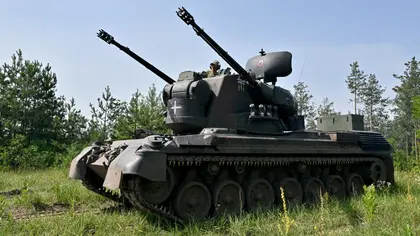The Ukrainian crew of the Gepard is rather proud of the four Russian drones and two missiles daubed in white on the armoured chassis of their German-made anti-aircraft tank.
"We've notched up six airborne targets already -- four Shaheds and two cruise missiles," says the tank commander, Roman, a muscled 27-year-old in a close-fitting khaki t-shirt.
JOIN US ON TELEGRAM
Follow our coverage of the war on the @Kyivpost_official.
"We shot them all down at night, except for one of the missiles," he says.
The Flakpanzer Gepard is stationed on a small, wooded hill somewhere in the Kyiv region, its two long automatic cannons primed for action. The soldiers ask AFP not to reveal its exact whereabouts.
Germany has already sent Ukraine 40 of these anti-aircraft gun tanks, which were developed in the 1970s and retired from the Bundeswehr after a decade or so.
Twelve more tanks and 300,000 rounds of ammunition are due to arrive shortly.
Along with other, often more modern, systems supplied by western nations, the Gepards are part of the air defence shield established by the Ukrainians in autumn 2022 to counter Russia bombing raids.
They were first installed around energy infrastructure and then major cities like Kyiv and the southern port of Odesa.
"We trained together in Germany for a month and a half. That was nearly a year ago," Roman says.
The Gepard has two 35mm guns mounted one on each side of a turret, capable of firing 500 times a minute. It has a search radar and sighting equipment.

Ukraine’s Navy Shoots Down Russian Missile – A New Air Defense Strategy?
"When the computer gives us the go ahead, I tell the commander and he opens fire on the target," explains 31-year-old Oleksii, the crew's gunner.
"The electronic system gets rid of human error and speeds things up so we can shoot down targets more quickly," Roman explains.
- 'Lives spared' -
Oleksii recalls their first success.
"We felt happy -- moved even. We shouted out loud. We were really chuffed to shoot that missile down because it was going at 600-700 kilometres an hour."
"I used to fire people up with cocktails. Now I fire on Russian missiles," the former barman grins.
His face hidden by a scarf, he says they also feel a sense of having done their duty, of "lives and infrastructure that have been spared".
"For us, each airborne enemy air target we shoot down is a small victory that gets us nearer the big one," Roman adds.
Manoeuvring a Gepard "isn't complicated really", says Oleksander, the 29-year-old driver.
"It's like driving an automatic car. Just a lot bigger," he says.
The last time they shot a missile down was in March.
How many have they missed?
"None," says Roman without hesitation.
Six weapons destroyed in nearly a year in that area.
But the days go by fast all the same, says Oleksander.
"We don't know where the time goes. One minute we're waking up, the next it's nearly evening and we have to try and sleep again."
The crew joined the army a few months after Russia invaded their country in February 2022. They have only had 12 days' leave since.
"Of course I miss it. It's hard being far away from your family," says the driver. He has a wife and two kids -- a girl of four and a boy of six.
Oleksii, the barman, dreams of opening his own cafe. "After the war of course. After we win."
For now "our job is to win".
"We shoot down drones and missiles. People's lives are saved. That's the only thing we think about right now."
You can also highlight the text and press Ctrl + Enter










